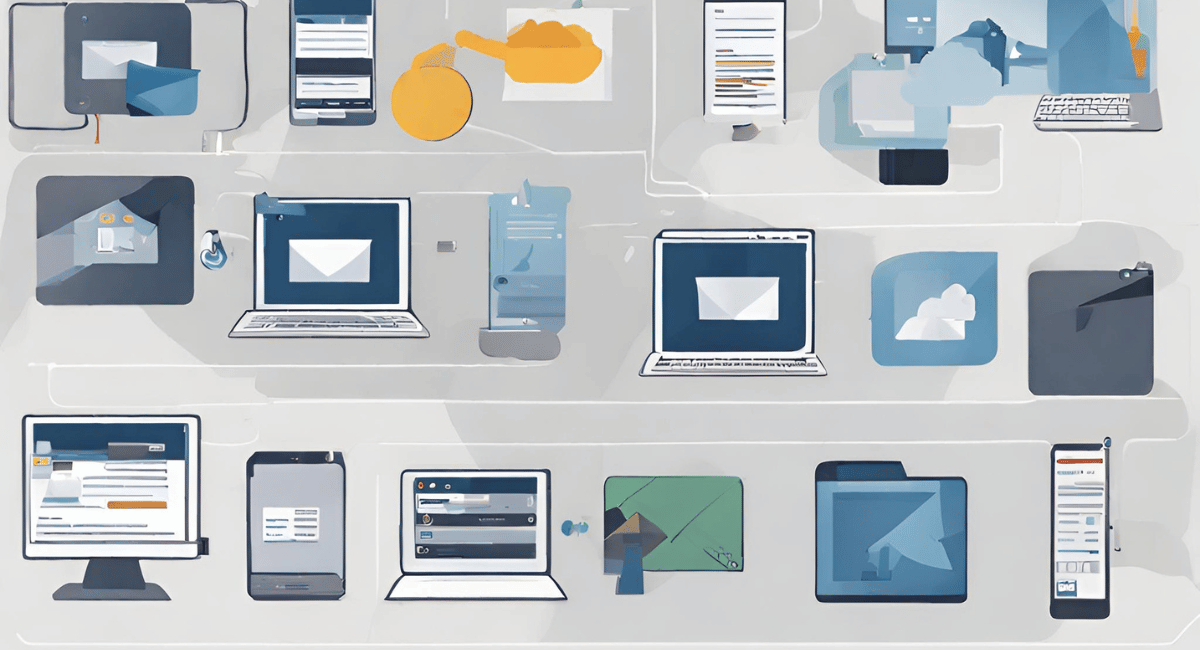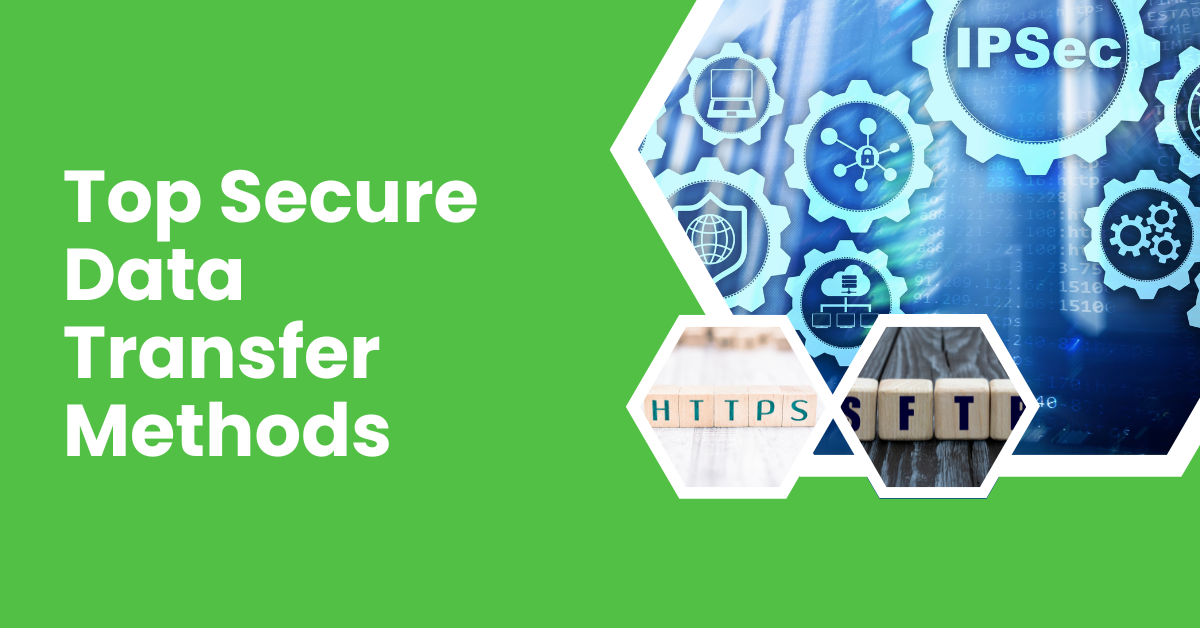The most secure data transfer methods utilize end-to-end encryption and protocols like HTTPS or SFTP.
In today’s digital age, data transfer is crucial in our personal and expert lives. Understanding the intricacies of data transfer is essential to safeguard the security and integrity of sensitive information. Together, we will delve into the various aspects of data transfer, explores the importance of secure data transfer, evaluates data transfer security, and examines the top secure data transfer methods. Additionally, it provides insights into the future of secure data transfer and emerging technologies in the field.
Understanding Data Transfer
Data transfer refers to affecting data from one location to another. It can occur within a single device or between multiple devices connected via a network. Whether sharing files, sending emails, or accessing websites, data transfer is fundamental to our daily interactions with technology.
When we send or receive data, it gets divided into smaller packets that traverse the network. These packets contain the necessary information for the data to reach its destination. The speed and efficiency of data transfer depend on factors such as bandwidth, latency, and network congestion.
Data transfer is not limited to just text-based information. It also includes transferring multimedia content such as images, videos, and audio files. These files are broken down into packets and transmitted across the network, allowing us to enjoy seamless streaming and download experiences.
Furthermore, data transfer plays a crucial role in cloud computing. Cloud services rely on data transfer to store and retrieve information from remote servers. This allows users to access their files and requests from anywhere worldwide, as long as they have an internet connection.
Importance of Secure Data Transfer
Secure data transfer is of utmost importance in today’s digital landscape. With cyber threats becoming increasingly sophisticated, protecting sensitive information has become a critical concern. Data breaches and unauthorized access can have severe consequences, including financial losses, reputational damage, and legal implications.
Ensuring secure data transfer involves implementing robust encryption algorithms, authentication protocols, and network channels. Encoding scrambles the data, making it unreadable to anyone who doesn’t have the decryption key. Authentication protocols verify the identity of the sender and receiver, preventing unauthorized access. Secure network channels, such as Virtual Private Networks (VPNs), create a secure tunnel for data to travel through, shielding it from potential eavesdroppers.
In addition to protecting sensitive data, secure data transfer helps maintain data integrity. Data integrity ensures that the information remains unchanged during the transfer process. Any alterations or corruptions in the data can be identified and corrected using checksums and error detection mechanisms.
Secure data transfer is crucial for businesses, organizations, and individuals. Personal info, such as credit card details, social security numbers, and passwords, must be transmitted securely to prevent identity theft and fraud.
Organizations can safeguard their data and protect their customers’ privacy by adopting secure practices. This includes regularly updating security measures, training employees on best practices, and conducting regular security checks. Moreover, individuals can protect their data by using strong and unique passwords, enabling two-factor authentication, and being cautious of phishing attempts.
Types of Data Transfer Methods

Data transfer methods are essential in our increasingly connected world. Whether sharing files with colleagues or backing up important data, understanding the different data transfer methods can help us make informed decisions. In this article, we will discover two common methods: physical data transfer and electronic data transfer.
Physical Data Transfer
Physical data transfer involves manually transporting data storage devices, such as USB drives, external hard drives, or DVDs. This method may seem outdated in the age of cloud storage and high-speed internet, but it still has its uses.
Imagine a scenario where you need to transfer massive data, such as a collection of high-resolution images or a large video project. Depending on your internet connection, uploading such files to the cloud could take hours or even days. In situations like these, physical data transfer can be a lifesaver.
Furthermore, physical data transfer can benefit areas with limited internet connectivity. Remote locations, rural areas, or even certain industries like offshore oil rigs may not have reliable internet access. In such cases, physically transporting data storage devices becomes the only viable option.
However, it’s important to note that physical data transfer carries certain risks. Loss, theft, or damage to the storage media can result in irretrievable data loss. Therefore, taking precautions, such as using encryption or making multiple copies of the data, is crucial to mitigate these risks.
Physical data transfer is also unsuitable for real-time or frequent data transfer needs. Electronic data transfer is a more efficient option if you require instant access to data or need to transfer files regularly.
Electronic Data Transfer

Electronic data transfer is the most common method used today. It encompasses various technologies and protocols enabling secure data exchange over networks.
Email attachments are one of the simplest forms of electronic data transfer. With just a few clicks, you can send files to recipients worldwide. However, email attachments have size limitations, and larger files may require alternative methods.
File-sharing services have gained popularity in recent years. Platforms like Dropbox, Google Drive, and OneDrive allow operators to upload files to the cloud and share them with others. These services offer convenience, as files can be regained from any device with an internet connection. They also provide collaboration features, making working on shared documents with colleagues easy.
Cloud storage stages like Amazon S3 or Microsoft Azure offer scalable solutions for businesses and individuals. These platforms provide secure and reliable storage for large amounts of data, allowing access from anywhere. They are particularly useful for organizations that require data redundancy and high availability.
Online collaboration tools, like Slack or Microsoft Teams, facilitate communication and seamless file sharing. These platforms integrate with other productivity tools, allowing teams to cooperate on documents, spreadsheets, and presentations in real time.
While electronic data transfer offers convenience, speed, and scalability, it’s important to prioritize security. Encryption, firewalls, and secure protocols are essential electronic data transfer security elements. Protecting sensitive information during transmission and storage is crucial to prevent unauthorized access or data breaches.
In conclusion, both physical data transfer and electronic data transfer have their advantages and disadvantages. Understanding the different methods and their suitability for specific scenarios can help individuals and organizations make informed decisions when transferring data.
Evaluating Data Transfer Security
Key Factors in Data Security
When evaluating data transfer security, several key factors come into play. One of the primary considerations is encryption. Data should be encoded both in transit and at rest to prevent unauthorized access. Robust encryption algorithms, such as Progressive Encryption Standard (AES), ensure that the data remains unreadable even if intercepted.
Authentication is another crucial aspect of data transfer security. Verifying the identity of users and devices involved in the transfer process helps mitigate the risk of unauthorized access or data manipulation. Strong authentication mechanisms, such as two-factor authentication, add an extra layer of security.
Network security is essential to protect data during transmission. Firewalls, Intrusion Detection Systems (IDS), and Virtual Private Networks (VPNs) help secure network channels and safeguard against external threats.
Common Vulnerabilities in Data Transfer
Despite advancements in data transfer security, vulnerabilities still exist. One common vulnerability is Man-in-the-Middle (MitM) attacks, where an attacker intercepts and alters the transferred data. Implementing secure protocols, such as HTTPS, can mitigate this risk.
Another vulnerability is outdated or weak encryption algorithms. It is critical to stay rationalized with the latest encryption standards and algorithms to ensure the highest level of data protection.
Human error and social engineering attacks also pose significant risks. Educating users about best practices, such as avoiding suspicious links and maintaining strong passwords, helps mitigate these threats.
Top Secure Data Transfer Methods

Secure File Transfer Protocol (SFTP)
SFTP is a secure alternative to the traditional File Transfer Protocol (FTP). It enhances an extra layer of security by encrypting data during transmission. SFTP employs Secure Shell (SSH) for authentication and data transfer. It is a widely-used protocol for securely transferring files over the internet.
Hypertext Transfer Protocol Secure (HTTPS)
HTTPS is an allowance of the standard HTTP protocol but adds encryption through Transport Layer Security (TLS) or Secure Sockets Layer (SSL). It safeguards secure communication between web browsers and servers. HTTPS is commonly used for secure online transactions and protecting sensitive data, such as passwords and credit card information.
Internet Protocol Security (IPSec)
IPSec is a robust protocol suite that provides secure communication across IP networks. It offers encryption, integrity verification, and authentication services. IPSec can be used to establish Virtual Private Networks (VPNs) for secure remote access or interconnecting private networks securely.
Future of Secure Data Transfer
Emerging Technologies in Data Security
The future of secure data transfer lies in emerging technologies that address evolving cybersecurity challenges. One such technology is blockchain, which offers transparent and immutable data transfer through its decentralized and cryptographic nature.
Artificial Intelligence (AI) is also important in enhancing data transfer security. AI-based systems can examine vast amounts of data in real time, detect anomalies, and identify threats or suspicious activities.
Predicted Trends in Secure Data Transfer

As technology advances, several trends are expected to shape the future of secure data transfer. Quantum encryption, leveraging the principles of quantum mechanics, holds promise for unbreakable encryption algorithms that would revolutionize data security.
Additionally, the increased adoption of Internet of Things (IoT) devices calls for enhanced security measures to protect data in transit between these interconnected devices. Secure protocols and authentication mechanisms specific to IoT environments will be essential.
Key Takeaways
- End-to-end encoding ensures only the sender and receiver can decipher the data.
- VPNs (Virtual Private Networks) add an extra layer of security during data transfers.
- Secure protocols like HTTPS, SFTP, or SCP are crucial for safe data transfers.
- Physical data transfers using encrypted hard drives can be very secure.
- Always ensure the software and platforms being used are up-to-date.
FAQs
Q: What is end-to-end encryption?
A: It’s a system where only the sender and receiver can decode the data, ensuring it remains private even if intercepted.
Q: Are wireless data transfers safe?
A: With proper encryption and secure networks, yes. However, always be wary of public Wi-Fi networks.
Q: Can VPNs guarantee safe data transfers?
A: VPNs add an extra layer of security, but like all systems, they aren’t infallible. Always use reputable VPN providers.
Q: How do I know if a website uses HTTPS?
A: Look for a padlock symbol in the browser’s address bar and ensure the URL begins with “https://.”
Q: Are there risks with physical data transfers?
A: While physical transfers reduce the risks of online interception, they can be lost, stolen, or corrupted. Encrypt and protect physical media.
Conclusion
In conclusion, The most secure data transfer methods today employ end-to-end encryption and utilize protocols such as HTTPS and SFTP, ensuring that sensitive information remains protected both during transmission and storage.
